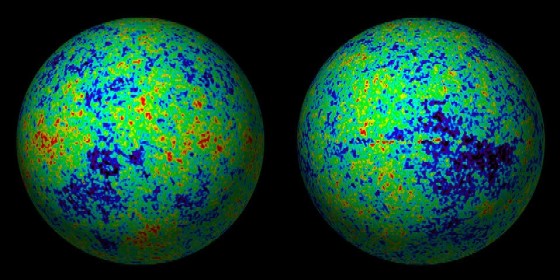The Age and Composition of the Universe

In one of the most important cosmological discoveries in years, NASA scientists have captured the most precise image of the universe, shedding light on its origins, age, and providing further evidence for the long-standing Big Bang and inflation theories. In Feb. 2003, a joint NASA–Princeton University satellite, the Wilkinson Microwave Anisotropic Probe (WMAP), produced a high-resolution map that captured the oldest light in the universe.
Ancient Light
This ancient light, called the cosmic microwave background, is the cooled remnant of the hot explosion known as the Big Bang. “The cosmic microwave light is a fossil,” explained David Wilkinson, after whom the probe was named, “Just as we can study dinosaur bones and reconstruct their lives of millions of years ago, we can probe this ancient light and reconstruct the universe as it was.” (Wilkinson died just before WMAP's amazing findings were published.)

Pictured above is the complete cosmic microwave background divided into two hemispheres as recorded by WMAP. Besides universe age, new data and analyses of the spots on the cosmic microwave background bolster existing indications that the universe is composed predominantly of a strange and mysterious type of dark energy (about 73 percent).
The age of the universe has now been accurately determined—with just a 1% margin of error—as 13.7 billion years old (previous estimates ranged between 8–20 billion years old). The birth of stars has been pinpointed to just 200 million years after the Big Bang, a surprise to most scientists (predictions had ranged from 500 million to 1 billion years after the cosmos formed).
The WMAP image also revealed the contents of the universe: only 4% is made up of atoms, or the physical universe as we know it. The remainder is made up of poorly understood substances: dark energy (73%) and dark matter (23%). These findings are consistent with the Big Bang and inflation theories, which assert that the universe materialized in a “big bang” and immediately began cooling and expanding. “I think every astronomer will remember where they were when they heard these results,” said John Bahcall, a Princeton University astrophysicist. “I certainly will. This announcement represents a rite of passage for cosmology from speculation to precision science.”
Five Easy Stats
How old is the universe? What is it made of? For the first time, scientists have clarity.
- 13.7 billion years: Age of the universe
- 200 million years: Interval betwen the Big Bang and the appearance of the first stars
- 4%: Proportion of the universe that is ordinary matter
- 23%: Proportion that is dark matter
- 73%: Proportion that is dark energy
